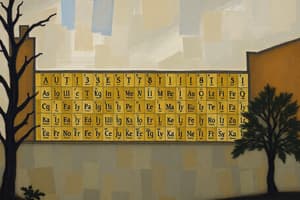Podcast
Questions and Answers
Which alkaline earth metal is the least reactive?
Which alkaline earth metal is the least reactive?
- Calcium
- Strontium
- Barium
- Beryllium (correct)
All alkaline earth metals tend to lose one electron during reactions.
All alkaline earth metals tend to lose one electron during reactions.
False (B)
What is the electronic configuration of magnesium?
What is the electronic configuration of magnesium?
[Ne] 3s²
Barium reacts _____ with water compared to other alkaline earth metals.
Barium reacts _____ with water compared to other alkaline earth metals.
Match the alkaline earth metal with its application:
Match the alkaline earth metal with its application:
What type of compounds do alkaline earth metals generally form with acids?
What type of compounds do alkaline earth metals generally form with acids?
All alkaline earth metals have their outermost electrons in the s orbital.
All alkaline earth metals have their outermost electrons in the s orbital.
The compound formed when calcium reacts with hydroxide is _____ .
The compound formed when calcium reacts with hydroxide is _____ .
Flashcards are hidden until you start studying
Study Notes
Properties Of Alkaline Earth Metals
- Group 2 Elements: Beryllium (Be), Magnesium (Mg), Calcium (Ca), Strontium (Sr), Barium (Ba), Radium (Ra).
- Physical Properties:
- Shiny, silvery-white metals.
- Low density and relatively low melting points (higher than alkali metals).
- Harder than alkali metals but softer than transition metals.
- Chemical Properties:
- Good conductors of electricity and heat.
- Form basic oxides and hydroxides, which react with acids to form salts.
- Tend to lose their two outermost electrons during reactions (forming +2 ions).
Trends In Reactivity
- Reactivity Increases Down the Group:
- Beryllium is the least reactive, while radium is the most reactive.
- Lower ionization energies as you move down the group facilitate easier electron loss.
- Reactions with Water:
- Reactivity with water increases down the group (e.g., magnesium reacts slowly with hot water, while barium reacts vigorously).
- Reactions with Halogens:
- Form ionic halides; reactivity with halogens also increases down the group.
Electronic Configurations
- Valence Electrons: All elements have two electrons in their outermost shell (s² configuration).
- Electronic Configurations:
- Beryllium: [He] 2s²
- Magnesium: [Ne] 3s²
- Calcium: [Ar] 4s²
- Strontium: [Kr] 5s²
- Barium: [Xe] 6s²
- Radium: [Rn] 7s²
Compounds Of Group 2
- Oxides:
- Form basic oxides (e.g., MgO, CaO); these react with acids to form salts.
- Hydroxides:
- Strong bases (e.g., Ca(OH)₂, Ba(OH)₂), soluble in water, forming alkaline solutions.
- Salts:
- React with acids to form various salts (e.g., CaCl₂, MgSO₄).
- Nitrates:
- Decompose upon heating, producing metal oxides and nitrogen dioxide.
Applications Of Alkaline Earth Metals
- Magnesium:
- Lightweight alloy production, aircraft, and automotive industries.
- Calcium:
- Essential for bone health, used in cement and mortars.
- Barium:
- Used in medical imaging (barium meals) and in producing fluorescent lights.
- Strontium:
- Employed in fireworks for red color and in some types of glass.
- Radium:
- Historically used in radiotherapy but is highly radioactive and hazardous.
Group 2 Elements - Alkaline Earth Metals
- Group 2 of the periodic table contains: Beryllium (Be), Magnesium (Mg), Calcium (Ca), Strontium (Sr), Barium (Ba), and Radium (Ra)
- They share silvery-white, shiny appearance
- Less dense than transition metals but denser than alkali metals
- They are harder than alkali metals but softer than transition metals
- They are good conductors of electricity and heat
- Group 2 metals readily react with oxygen to form basic oxides
- They react with water to form hydroxides, which are also basic
- These hydroxides readily react with acids, forming salts
- Group 2 metals lose their two outermost electrons to form +2 ions, resulting in ionic compounds
Reactivity Trends
- Reactivity increases down the group, with Beryllium being the least reactive and Radium being the most reactive
- This trend is due to decreasing ionization energy, making it easier to lose electrons moving down the group
- Reaction with water is a good example of increasing reactivity. Magnesium reacts slowly with hot water, while barium reacts vigorously.
- Their reactivity with halogens also increases down the group, resulting in ionic halides.
Electronic Configuration
- All Group 2 elements have their two valence electrons in their outermost s orbital, leading to a s² configuration.
- Specific electronic configurations are:
- Beryllium: [He] 2s²
- Magnesium: [Ne] 3s²
- Calcium: [Ar] 4s²
- Strontium: [Kr] 5s²
- Barium: [Xe] 6s²
- Radium: [Rn] 7s²
Compounds of Group 2
- Oxides: Group 2 metals form basic oxides, such as MgO and CaO, which produce salts when reacted with acids.
- Hydroxides: Group 2 metals form strong bases, such as Ca(OH)₂ and Ba(OH)₂, which are soluble in water and create alkaline solutions.
- Salts: These metals react with various acids to produce salts like CaCl₂ and MgSO₄.
- Nitrates: Heating Group 2 nitrates decomposes them into metal oxides and nitrogen dioxide.
Applications of Alkaline Earth Metals
- Magnesium: Used in lightweight alloys for aircraft and automotive industries.
- Calcium: Essential element for bone health, also used in cement and mortars.
- Barium: Used in medical imaging (barium meals), and in producing fluorescent lights.
- Strontium: Used in fireworks to produce red color and in specific types of glass.
- Radium: Historically used in radiotherapy, but highly radioactive and hazardous.
Studying That Suits You
Use AI to generate personalized quizzes and flashcards to suit your learning preferences.




